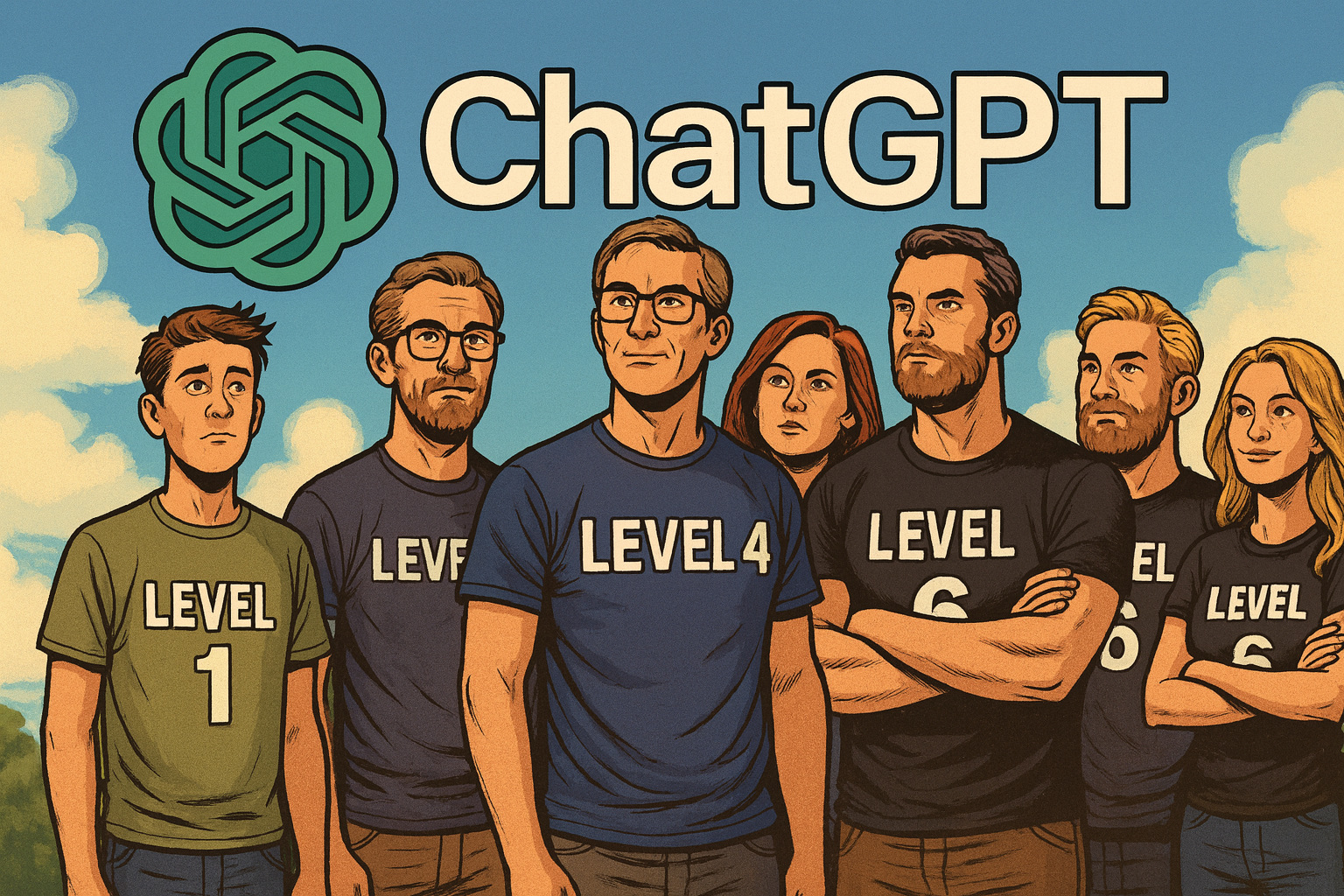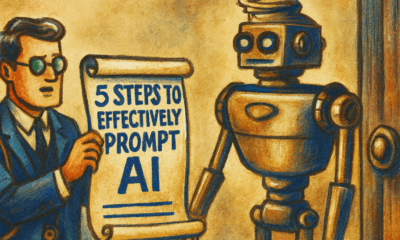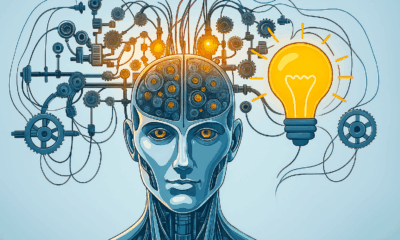Education
The Amazing World of Machine Learning: How Computers Learn Like HumansHow Computers Learn

- Share
- Tweet /data/web/virtuals/375883/virtual/www/domains/spaisee.com/wp-content/plugins/mvp-social-buttons/mvp-social-buttons.php on line 63
https://spaisee.com/wp-content/uploads/2025/06/edu3-1-1000x600.webp&description=The Amazing World of Machine Learning: How Computers Learn Like HumansHow Computers Learn', 'pinterestShare', 'width=750,height=350'); return false;" title="Pin This Post">
Have you ever wondered how your phone can recognize your face or how Netflix knows exactly which show you’ll love next? It’s not magic—it’s machine learning! This incredible technology lets computers learn from experience, just like you do when you practice a new skill. In this article, we’ll explore how computers can “think” and make decisions. Since we can’t draw pictures here, we’ll describe some cool images to help you imagine how it all works. Get ready to dive into the amazing world of machine learning!
What is Machine Learning?
Imagine you’re learning to ride a bike. At first, you wobble and maybe even fall, but with each try, you get a little better. Soon, you’re zooming around without a second thought! Machine learning (ML) works the same way. Instead of following strict instructions, computers learn from examples and experiences to make decisions or predictions.
Here’s the big difference:
- In traditional programming, you give the computer data and rules, and it gives you results. (Like telling it, “Add 2 + 3 to get 5.”)
- In machine learning, you give the computer data and the results you want, and it figures out the rules on its own. (Like showing it pictures of cats and dogs, and letting it learn what makes a cat a cat.)
Real-World Example: Think about how your email knows which messages are spam. It learns from past emails you’ve marked as junk and uses that to decide about new ones. Cool, right?
Perceptrons: The Simple Decision-Makers
A perceptron is the simplest kind of neural network, like a single neuron making a basic decision. It’s great for answering yes-or-no questions, like “Is this email spam?”
Here’s how it works:
- It takes in several inputs (like words in an email: “free,” “win,” “money”).
- Each input has a weight (how important it is).
- It adds everything up, adds a little extra number called bias, and decides: “Yes, spam!” or “No, not spam!”
If it makes a mistake, it adjusts the weights to get better next time, just like you learn from mistakes.
Real-World Example: Think of a perceptron deciding whether you should go outside. Inputs could be “Is it raining?” or “Is it cold?” Based on those, it says “Yes, go out!” or “No, stay in!”
Components of the perceptron:
- Inputs (features): Numerical values representing measurable characteristics of data.
- Weights: Parameters that determine the influence of each input.
- Bias: A constant added to shift the activation function’s threshold.
- Activation Function: Typically, a step function for basic models, it determines the binary outcome.
Neural Networks: The Brain-Inspired Team
Now, let’s talk about neural networks—the superstars of machine learning. These are like a team of tiny brain cells (called neurons) working together to solve problems.
They’re inspired by how our own brains process information!
A neural network has three main parts:
- Input Layer: This is where the data enters. For example, if you’re looking at a picture, each tiny dot (pixel) is an input.
- Hidden Layers: These are the “thinking” layers. They process the data, find patterns, and pass information along.
- Output Layer: This gives the final answer, like “Yes, that’s a cat!” or “No, that’s a dog.”
Each connection between neurons has a weight, which shows how important that connection is. The network learns by adjusting these weights, like strengthening the connections that lead to the right answer.
How It Learns:
- First, data flows through the network from input to output (called forward propagation).
- If the answer is wrong, the network tweaks the weights to do better next time (called backpropagation). It’s like practicing to improve!
Neural Networks Structure: Building a Team
Most neural networks today are multi-layer perceptrons (MLPs), which means they have at least one hidden layer. This lets them learn more complicated things than a single perceptron can.
Here’s the structure again:
- Input Layer: Where data comes in.
- Hidden Layers: Where the magic happens—finding patterns step by step.
- Output Layer: Where the final decision is made.
Why Hidden Layers Matter: Each hidden layer can learn different features. For example, in a picture:
- The first hidden layer might learn to find edges.
- The next might learn shapes like circles or squares.
- The last might put it all together to recognize a face or an animal.
Deep Neural Networks: Going Deeper for Smarter Learning
When a neural network has many hidden layers, it’s called a deep neural network (DNN). These are like super-powered learners that can handle really tough tasks, like recognizing objects in messy photos or understanding speech in a noisy room.
Why So Many Layers? More layers mean the network can learn step by step, building up from simple to complex ideas. For example:
- Early layers might learn basic shapes.
- Middle layers might learn parts of objects, like eyes or wheels.
- Later layers might learn entire objects, like cats or cars.
Challenge: Sometimes, with too many layers, the network can get confused, and learning slows down. But smart designs, like skip connections, help by letting information jump over some layers, keeping things moving smoothly.
Deep Learning: The Future is Here
Deep learning is a special part of machine learning that uses deep neural networks. It’s behind some of the coolest tech you use every day:
- Self-driving cars that can see and react to the road.
- Voice assistants like Siri or Alexa understand your questions.
- Apps that recognize your face to unlock your phone.
What makes deep learning so powerful is that it can learn directly from raw data (like pixels in a photo) without needing humans to tell it what to look for. It’s like teaching a computer to see and hear like we do!
Fun Fact: Inspired by You!
Did you know neural networks were inspired by the human brain? Your brain has about 86 billion neurons, all working together to help you think, learn, and remember. Even though computer networks are much simpler, they use the same idea of connecting tiny units to solve big problems. Who knows? Maybe one day, you’ll create the next big breakthrough in machine learning!
Conclusion
Machine learning is like giving computers a superpower—the ability to learn and improve, just like we do. From simple decisions to recognizing faces and driving cars, this technology is changing the world in amazing ways. And the best part? You’re just getting started on your journey to understand it. Keep exploring, stay curious, and maybe one day, you’ll teach a computer something new!
Education
A Turning Point in AI: OpenAI’s “AI Progress and Recommendations”

Capabilities Advancing, but the World Stays the Same
In a post shared recently by Sam Altman, OpenAI laid out a new framework reflecting just how far artificial intelligence has come — and how far the company believes we have yet to go. The essay begins with the recognition that AI systems today are performing at levels unimaginable only a few years ago: they’re solving problems humans once thought required deep expertise, and doing so at dramatically falling cost. At the same time, OpenAI warns that the gap between what AI is capable of and what society is actually experiencing remains vast.
OpenAI describes recent AI progress as more than incremental. Tasks that once required hours of human effort can now be done by machines in minutes. Costs of achieving a given level of “intelligence” from AI models are plummeting — OpenAI estimates a roughly forty-fold annual decline in cost for equivalent capability. Yet while the technology has advanced rapidly, everyday life for most people remains largely unchanged. The company argues that this reflects both the inertia of existing systems and the challenge of weaving advanced tools into the fabric of society.
Looking Ahead: What’s Next and What to Expect
OpenAI forecasts that by 2026 AI systems will be capable of “very small discoveries” — innovations that push beyond merely making human work more efficient. By 2028 and beyond, the company believes we are likely to see systems that can make even more significant discoveries — though it acknowledges the uncertainties inherent in such predictions. The post also underscores that the future of AI is not just about smarter algorithms, but about shaped social, economic and institutional responses.
A Framework for Responsible Progress
The document outlines three major pillars that OpenAI deems essential for navigating the AI transition responsibly. First, labs working at the frontier must establish shared standards, disclose safety research, and coordinate to avoid destructive “arms-race” dynamics. In OpenAI’s view, this is akin to how building codes and fire standards emerged in prior eras.
Second, there must be public oversight and accountability aligned with the capabilities of the technology — meaning that regulations and institutional frameworks must evolve in concert with rising AI power. OpenAI presents two scenarios: one in which AI evolves in a “normal” mode and traditional regulatory tools suffice, the other in which self-improving or super-intelligent systems behave in novel ways and demand new approaches.
Third, the concept of an “AI resilience ecosystem” is introduced — a system of infrastructure, monitoring, response teams and tools, analogous to the cybersecurity ecosystem developed around the internet. OpenAI believes such resilience will be crucial regardless of how fast or slow AI evolves.
Societal Impact and Individual Empowerment
Underlying the vision is the belief that AI should not merely make things cheaper or faster, but broaden access and improve lives. OpenAI expects AI to play major roles in fields like healthcare diagnostics, materials science, climate modeling and personalized education — and aims for advanced AI tools to become as ubiquitous as electricity, clean water or connectivity. However, the transition will be uneven and may strain the socioeconomic contract: jobs will change, institutions may be tested, and we may face hard trade-offs in distribution of benefit.
Why It Matters
This statement represents a turning point — not just for OpenAI, but for the AI ecosystem broadly. It signals that leading voices are shifting from what can AI do to how should AI be governed, deployed and embedded in society. For investors, policy-makers and technologists alike, the message is clear: the existence of powerful tools is no longer the question. The real question is how to capture their upside while preventing cascading risk.
In short, OpenAI is saying: yes, AI is now extremely capable and moving fast. But the institutions, policies and social frameworks around it are still catching up. The coming years are not just about brighter tools — they’re about smarter integration. And for anyone watching the next phase of generative AI, this document offers a foundational lens.
AI Model
How to Get Factual Accuracy from AI — And Stop It from “Hallucinating”

Everyone wants an AI that tells the truth. But the reality is — not all AI outputs are created equal. Whether you’re using ChatGPT, Claude, or Gemini, the precision of your answers depends far more on how you ask than what you ask. After months of testing, here’s a simple “six-level scale” that shows what separates a mediocre chatbot from a research-grade reasoning engine.
Level 1 — The Basic Chat
The weakest results come from doing the simplest thing: just asking.
By default, ChatGPT uses its Instant or fast-response mode — quick, but not very precise. It generates plausible text rather than verified facts. Great for brainstorming, terrible for truth.
Level 2 — The Role-Play Upgrade
Results improve dramatically if you use the “role play” trick. Start your prompt with something like:
“You are an expert in… and a Harvard professor…”
Studies confirm this framing effect boosts factual recall and reasoning accuracy. You’re not changing the model’s knowledge — just focusing its reasoning style and tone.
Level 3 — Connect to the Internet
Want better accuracy? Turn on web access.
Without it, AI relies on training data that might be months (or years) old.
With browsing enabled, it can pull current information and cross-check claims. This simple switch often cuts hallucination rates in half.
Level 4 — Use a Reasoning Model
This is where things get serious.
ChatGPT’s Thinking or Reasoning mode takes longer to respond, but its answers rival graduate-level logic. These models don’t just autocomplete text — they reason step by step before producing a response. Expect slower replies but vastly better reliability.
Level 5 — The Power Combo
For most advanced users, this is the sweet spot:
combine role play (2) + web access (3) + reasoning mode (4).
This stack produces nuanced, sourced, and deeply logical answers — what most people call “AI that finally makes sense.”
Level 6 — Deep Research Mode
This is the top tier.
Activate agent-based deep research, and the AI doesn’t just answer — it works. For 20–30 minutes, it collects, verifies, and synthesizes information into a report that can run 10–15 pages, complete with citations.
It’s the closest thing to a true digital researcher available today.
Is It Perfect?
Still no — and maybe never will be.
If Level 1 feels like getting an answer from a student doing their best guess, then Level 4 behaves like a well-trained expert, and Level 6 performs like a full research team verifying every claim. Each step adds rigor, depth, and fewer mistakes — at the cost of more time.
The Real Takeaway
When people say “AI is dumb,” they’re usually stuck at Level 1.
Use the higher-order modes — especially Levels 5 and 6 — and you’ll see something different: an AI that reasons, cites, and argues with near-academic depth.
If truth matters, don’t just ask AI — teach it how to think.
AI Model
81% Wrong: How AI Chatbots Are Rewriting the News With Confident Lies

In 2025, millions rely on AI chatbots for breaking news and current affairs. Yet new independent research shows these tools frequently distort the facts. A European Broadcasting Union (EBU) and BBC–supported study found that 45% of AI-generated news answers contained significant errors, and 81% had at least one factual or contextual mistake. Google’s Gemini performed the worst, with sourcing errors in roughly 72% of its responses. The finding underscores a growing concern: the more fluent these systems become, the harder it is to spot when they’re wrong.
Hallucination by Design
The errors aren’t random; they stem from how language models are built. Chatbots don’t “know” facts—they generate text statistically consistent with their training data. When data is missing or ambiguous, they hallucinate—creating confident but unverified information.
Researchers from Reuters, the Guardian, and academic labs note that models optimized for plausibility will always risk misleading users when asked about evolving or factual topics.
This pattern isn’t new. In healthcare tests, large models fabricated medical citations from real journals, while political misinformation studies show chatbots can repeat seeded propaganda from online data.
Why Chatbots “Lie”
AI systems don’t lie intentionally. They lack intent. But their architecture guarantees output that looks right even when it isn’t. Major causes include:
- Ungrounded generation: Most models generate text from patterns rather than verified data.
- Outdated or biased training sets: Many systems draw from pre-2024 web archives.
- Optimization for fluency over accuracy: Smooth answers rank higher than hesitant ones.
- Data poisoning: Malicious actors can seed misleading information into web sources used for training.
As one AI researcher summarized: “They don’t lie like people do—they just don’t know when they’re wrong.”
Real-World Consequences
- Public trust erosion: Users exposed to polished but false summaries begin doubting all media, not just the AI.
- Amplified misinformation: Wrong answers are often screenshot, shared, and repeated without correction.
- Sector-specific risks: In medicine, law, or finance, fabricated details can cause real-world damage. Legal cases have already cited AI-invented precedents.
- Manipulation threat: Adversarial groups can fine-tune open models to deliver targeted disinformation at scale.
How Big Is the Problem?
While accuracy metrics are worrying, impact on audiences remains under study. Some researchers argue the fears are overstated—many users still cross-check facts. Yet the speed and confidence of AI answers make misinformation harder to detect. In social feeds, the distinction between AI-generated summaries and verified reporting often vanishes within minutes.
What Should Change
- Transparency: Developers should disclose when responses draw from AI rather than direct source retrieval.
- Grounding & citations: Chatbots need verified databases and timestamped links, not “estimated” facts.
- User literacy: Treat AI summaries like unverified tips—always confirm with original outlets.
- Regulation: Oversight may be necessary to prevent automated systems from impersonating legitimate news.
The Bottom Line
The 81% error rate is not an isolated glitch—it’s a structural outcome of how generative AI works today. Chatbots are optimized for fluency, not truth. Until grounding and retrieval improve, AI remains a capable assistant but an unreliable journalist.
For now, think of your chatbot as a junior reporter with infinite confidence and no editor.
-

 AI Model2 months ago
AI Model2 months agoHow to Use Sora 2: The Complete Guide to Text‑to‑Video Magic
-

 AI Model4 months ago
AI Model4 months agoTutorial: How to Enable and Use ChatGPT’s New Agent Functionality and Create Reusable Prompts
-

 AI Model5 months ago
AI Model5 months agoComplete Guide to AI Image Generation Using DALL·E 3
-

 AI Model5 months ago
AI Model5 months agoMastering Visual Storytelling with DALL·E 3: A Professional Guide to Advanced Image Generation
-

 AI Model3 months ago
AI Model3 months agoTutorial: Mastering Painting Images with Grok Imagine
-

 News2 months ago
News2 months agoOpenAI’s Bold Bet: A TikTok‑Style App with Sora 2 at Its Core
-

 AI Model7 months ago
AI Model7 months agoGrok: DeepSearch vs. Think Mode – When to Use Each
-

 Tutorial2 months ago
Tutorial2 months agoFrom Assistant to Agent: How to Use ChatGPT Agent Mode, Step by Step











